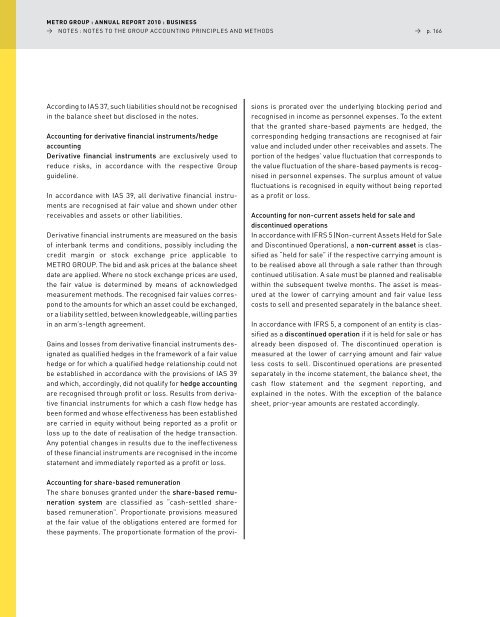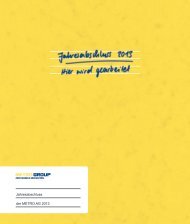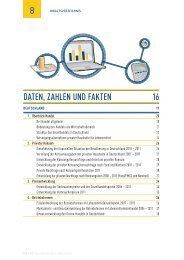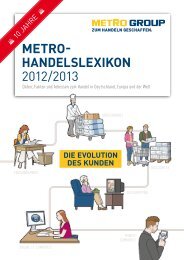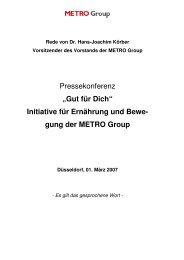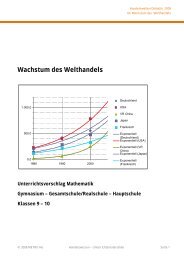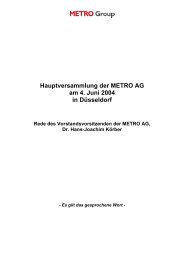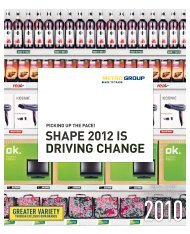pdf (2.5 MB) - METRO Group
pdf (2.5 MB) - METRO Group
pdf (2.5 MB) - METRO Group
Create successful ePaper yourself
Turn your PDF publications into a flip-book with our unique Google optimized e-Paper software.
<strong>METRO</strong> GROUP : ANNUAL REPORT 2010 : BUSINESS<br />
→ NOTES : NOTES TO ThE GROuP ACCOuNTING PRINCIPlES ANd METhOdS<br />
According to IAS 37, such liabilities should not be recognised<br />
in the balance sheet but disclosed in the notes.<br />
Accounting for derivative financial instruments/hedge<br />
accounting<br />
Derivative financial instruments are exclusively used to<br />
reduce risks, in accordance with the respective <strong>Group</strong><br />
guideline.<br />
In accordance with IAS 39, all derivative financial instruments<br />
are recognised at fair value and shown under other<br />
receivables and assets or other liabilities.<br />
derivative financial instruments are measured on the basis<br />
of interbank terms and conditions, possibly including the<br />
credit margin or stock exchange price applicable to<br />
<strong>METRO</strong> GROuP. The bid and ask prices at the balance sheet<br />
date are applied. Where no stock exchange prices are used,<br />
the fair value is determined by means of acknowledged<br />
measurement methods. The recognised fair values correspond<br />
to the amounts for which an asset could be exchanged,<br />
or a liability settled, between knowledgeable, willing parties<br />
in an arm’s-length agreement.<br />
Gains and losses from derivative financial instruments designated<br />
as qualified hedges in the framework of a fair value<br />
hedge or for which a qualified hedge relationship could not<br />
be established in accordance with the provisions of IAS 39<br />
and which, accordingly, did not qualify for hedge accounting<br />
are recognised through profit or loss. Results from derivative<br />
financial instruments for which a cash flow hedge has<br />
been formed and whose effectiveness has been established<br />
are carried in equity without being reported as a profit or<br />
loss up to the date of realisation of the hedge transaction.<br />
Any potential changes in results due to the ineffectiveness<br />
of these financial instruments are recognised in the income<br />
statement and immediately reported as a profit or loss.<br />
Accounting for share-based remuneration<br />
The share bonuses granted under the share-based remuneration<br />
system are classified as “cash-settled sharebased<br />
remuneration”. Proportionate provisions measured<br />
at the fair value of the obligations entered are formed for<br />
these payments. The proportionate formation of the provi-<br />
→ p. 166<br />
sions is prorated over the underlying blocking period and<br />
recognised in income as personnel expenses. To the extent<br />
that the granted share-based payments are hedged, the<br />
corresponding hedging transactions are recognised at fair<br />
value and included under other receivables and assets. The<br />
portion of the hedges’ value fluctuation that corresponds to<br />
the value fluctuation of the share-based payments is recognised<br />
in personnel expenses. The surplus amount of value<br />
fluctuations is recognised in equity without being reported<br />
as a profit or loss.<br />
Accounting for non-current assets held for sale and<br />
discontinued operations<br />
In accordance with IfRS 5 (Non-current Assets held for Sale<br />
and discontinued Operations), a non-current asset is classified<br />
as “held for sale” if the respective carrying amount is<br />
to be realised above all through a sale rather than through<br />
continued utilisation. A sale must be planned and realisable<br />
within the subsequent twelve months. The asset is measured<br />
at the lower of carrying amount and fair value less<br />
costs to sell and presented separately in the balance sheet.<br />
In accordance with IfRS 5, a component of an entity is classified<br />
as a discontinued operation if it is held for sale or has<br />
already been disposed of. The discontinued operation is<br />
measured at the lower of carrying amount and fair value<br />
less costs to sell. discontinued operations are presented<br />
separately in the income statement, the balance sheet, the<br />
cash flow statement and the segment reporting, and<br />
explained in the notes. With the exception of the balance<br />
sheet, prior-year amounts are restated accordingly.


